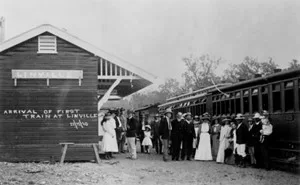On 22 January 2007, the then Deputy Premier, Ms. Anna Bligh, announced the development of three new recreational trails in Queensland. One of these involved the conversion of the disused Brisbane Valley Rail Line into a 140k recreational trail from Ipswich to Blackbutt through the historic towns of Coominya, Fernvale, Lowood, Esk, Toogoolawah, Moore and Linville. It was to be open to pedestrians, cyclists and horse riders only and sections of this rail trail have been opened progressively since that time. It has now been extended to the original rail terminus at Yarraman.
Brisbane Valley Heritage Trails was successful in nominating two pieces of existing railway infrastructure on this line for the Qld. Heritage Register, and they were the Yimbun tunnel (the only tunnel on the line) and the Harlin Bridge. Interpretive signage at the existing railway stations and on the Blackbutt Range is another contribution to the Brisbane Valley Rail Trail by Brisbane Valley Heritage Trails Inc.
Further information about the Brisbane Valley Rail Trail may be obtained from brisbanevalleyrailtrail.com.au
The original Rail Line through the Brisbane Valley was designed to provide supplies to the developing settlements of small farmers in the valley, and to transport milk products, timber and stock to Brisbane markets.
For reasons that seem insufficient today, the Brisbane Valley Rail Line and the Blackbutt Extension finished with a terminus at Yarraman rather than joining the line at Nanango.
The major stations along this line were at Wulkaraka (previously called Brisbane Valley Junction), Fernvale, Lowood (opened 16 June 1884), Coominya (originally called Bellevue), Esk (opened 9 August 1886), Ottaba, Toogoolawah (opened 8 February 1904), Moorabool (terminus 1904), Harlin (in use May 1910), Moore, Nurinda (in use July 1910), Linville (opened 22 November 1910), Benarkin/Blackbutt, Gilla (opened 19 December 1912) and Yarraman Creek (opened 2 May 1913). There was a bus and truck service for passengers to and from Yarraman to Cooyar and Goombungee in the Rosalie Shire and a similar service between Nanango and Yarraman. Today only the station of Wulkuraka outside Ipswich remains open. The Brisbane Valley Line was subject to land slip and flooding and the last regular Ipswich to Yarraman steam train ran on 29 November 1969. The last rail motor service finished in 1989 and the railway line through the Brisbane Valley was finally closed in that year.
Today only some of the stations survive. Lowood Station has been restored in situ and the rail trail between Fernvale and Lowood along the Brisbane River is available for recreational use. It is the location of an annual Fun Run in July organised by the Somerset Regional Council. Esk Station is currently in disrepair and awaiting restoration has been beautifully restored as a community facility for the town of Esk. Toogoolawah Station is in good repair, having been in continual use by Q-Link until December 2005. The Linville Station has been restored and now serves as a museum for recreational visitors to the Brisbane Valley Rail Trail at the beginning of the 23k Blackbutt Range Track Rail Trail that is now open for recreational use between Linville, Benarkin and Blackbutt. Yarraman Railway Station has been relocated and now stands in the grounds of Yarraman Heritage Centre. It has also been restored and is available to the public. The ticket box from the Nanango Railway Station is still in use at the Nanango Race Course.

Perhaps the most interesting feature of the Rail Trails of the Brisbane Valley is borrowed from the Cooyar rail line. Here can be found the Muntapa Tunnel that is reported to be the longest railway tunnel in the Southern hemisphere. Further information about this tunnel can be obtained from the Toowoomba Regional Council. After the closure of this rail line as well, the tunnel became the very welcome home to a large bat colony
To celebrate the opening of the Linville to Blackbutt section of the Rail Trail in 2006, the stories of some of the men who worked and died building the Blackbutt Extension were included in a book, “Building the Line”, sponsored by an ANZ Bank ‘Seeds of Renewal’ grant. This documents the hardships, the drunken brawling, the fatal accidents, the vision and the endurance of the men who worked the line, and whose contribution is often overshadowed by an educated elite whose view of history has always prevailed.
Brisbane Valley Heritage Trails has a wealth of old photos from the early days of the Brisbane Valley Line as well as the stories, accurate and apocryphal, of the working man, including the railway men. These stories were published as “Larrikin Tales of the Brisbane Valley”.

